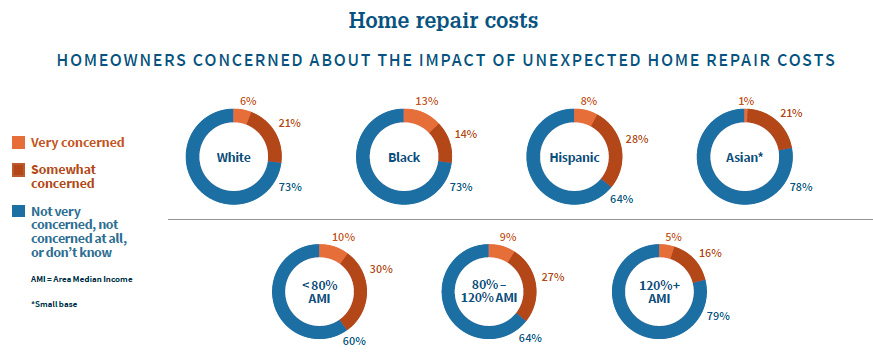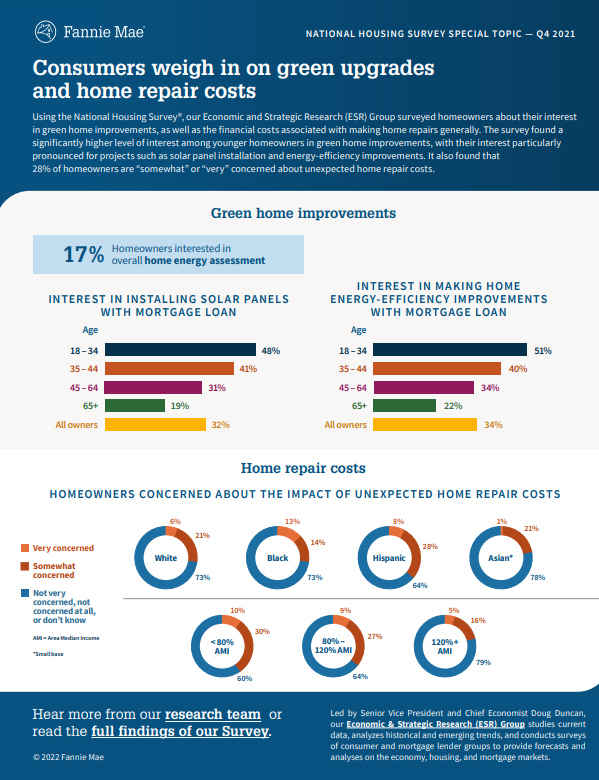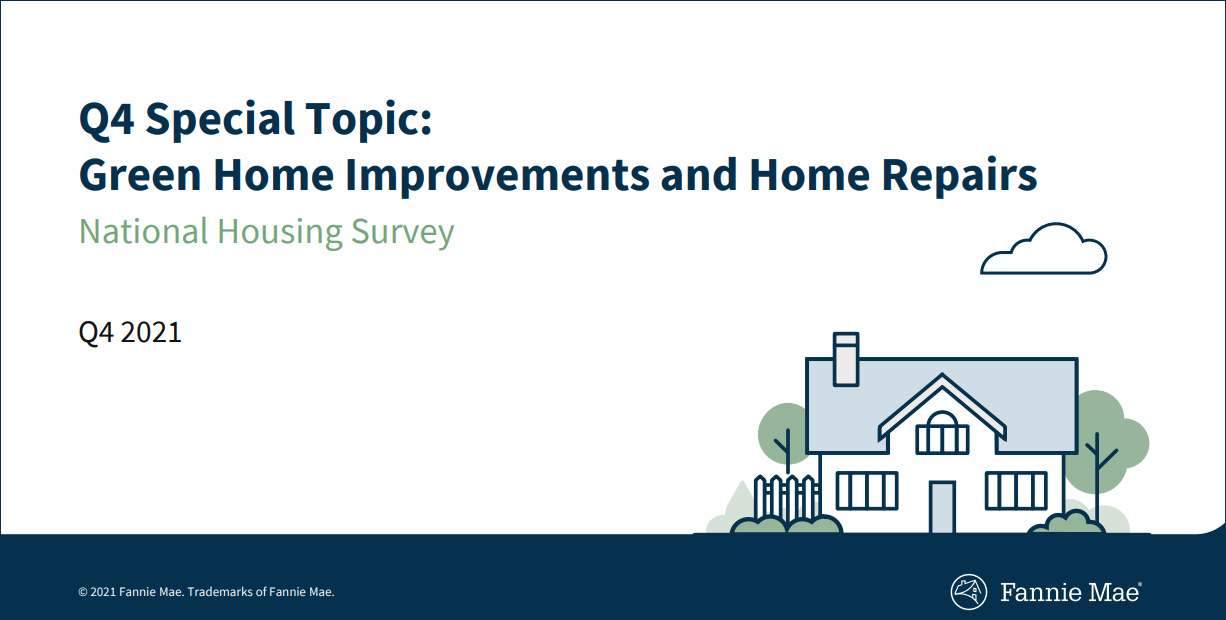Expect the Unexpected: Green Upgrades and Home Repair Costs
Late last year, we leveraged our National Housing Survey® to ask homeowners about their interest in "green" home improvements, as well as the financial costs associated with making home repairs generally. With environmental concerns and energy efficiency increasingly top of mind for many, we wanted to better understand consumers' interest in installing solar panels or making other energy-efficiency improvements, particularly if the costs of doing so were included in their mortgage balance.
Our survey identified a significantly higher level of interest among younger homeowners in green home improvements, with their interest particularly pronounced for projects such as solar panel installation and energy-efficiency improvements. We also found that 28% of homeowners are "somewhat" or "very" concerned about unexpected home repair costs. Notably, one-third of homeowners indicated that the costs required to make home repairs were higher than expected, and 28% expressed concern that unexpected repair costs could make it difficult to pay their mortgage or other monthly bills.
Examining Homeowner Interest in "Green" Home Improvements
Overall, approximately half of homeowners aged 18-34 would be interested in making energy-efficiency improvements (51%) or installing solar panels (48%), if the costs for these upgrades could be included in their mortgage. Both of these figures were far higher than the average level of interest across the general population of homeowners (34% and 32%, respectively).
Additionally, 26% of homeowners aged 18-34 expressed interest in an overall home energy assessment costing a few hundred dollars. This was, again, much higher than the interest among all homeowners (17%).
Exploring the Impact and Types of Home Repair and Improvement Costs
As discussed in a recent Fannie Mae Perspectives blog, the combined cost of home repairs and improvements can make up nearly 20% of the total cost of homeownership. It's also clear from these survey results that this is an unexpected burden for a meaningful portion of homeowners.
Large, unexpected home repair costs can adversely affect housing stability, as some homeowners, especially those of more modest means, may struggle to keep up with both their mortgage payments and the often-costly repairs necessary to maintain their homes. Our survey results revealed that 38% of lower-income homeowners (i.e., those earning less than 80% of area median income (AMI)) believe their home repair costs were higher than expected, compared to 30% of higher-income consumers (i.e., those earning more than 120% AMI). The results also plainly showed that higher unexpected repair costs are likely to have a disproportionate effect on lower-income consumers: While 28% of homeowners overall said unexpected repair costs would make them concerned about their ability to pay their mortgage or other monthly bills, that number rose to 40% among lower-income consumers -- compared to only 21% for higher-income consumers.
Moreover, among the 28% of homeowners who expressed concern about unexpected repair costs potentially impeding their ability to pay their bills, 60% said the older condition of their home necessitates repairs, while 20% said they need repairs due to remodeling. Twenty-five percent plan to conduct large or very large repairs (e.g., room additions, exterior and/or interior structures, HVAC units), and they were significantly more likely to label these repairs as cost-burdensome. Hispanic and Black homeowners, as well as lower- to moderate-income consumers (i.e., homeowners earning less than 120% AMI), were more likely to be very or somewhat concerned about unexpected repair costs compared to other groups.
Click image above for larger view
We also asked about the costliness of certain types of home repairs. The most financially burdensome repairs cited by homeowners were those to the exterior structure of the home (e.g., the roof, siding, windows), followed by those to HVAC units, and repairs to appliances or other major equipment (e..g, refrigerator, water heater).
Home repairs and improvements, including green improvements, may help protect homeowners from climate- and energy cost-related financial shocks. It's possible that, for many homeowners, recent home price gains have elevated home equity levels such that some households may now be able to finance these improvements. However, lower-income consumers are less likely to have invested in home repairs and preventative maintenance1 , potentially setting them up for unexpected costs in the future that our findings indicate may be difficult to manage. It's critical that all homeowners are able to budget for home repairs and maintenance to help avoid significant – and unexpected – financial hardship.
To learn more, access the associated research deck or check out the high-level infographic.
July 19, 2022
The author thanks Matt Classick, Steve Deggendorf, Li-Ning Huang, Mark Palim and Rachel Zimmerman (in alphabetical order) for valuable contributions in the creation of this commentary and the design of the research. Of course, all errors and omissions remain the responsibility of the authors.
Opinions, analyses, estimates, forecasts, and other views of Fannie Mae's Economic & Strategic Research (ESR) Group or survey respondents included in these materials should not be construed as indicating Fannie Mae's business prospects or expected results, are based on a number of assumptions, and are subject to change without notice. How this information affects Fannie Mae will depend on many factors. Although the ESR Group bases its opinions, analyses, estimates, forecasts, and other views on information it considers reliable, it does not guarantee that the information provided in these materials is accurate, current, or suitable for any particular purpose. Changes in the assumptions or the information underlying these views could produce materially different results. The analyses, opinions, estimates, forecasts, and other views published by the ESR Group or survey respondents represent the views of that group as of the date indicated and do not necessarily represent the views of Fannie Mae or its management.





